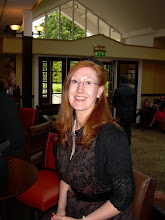 In between getting Russian visas yesterday, I popped into the National Portrait Gallery to have a look at the Wyndham Lewis portraits exhibition. I know more about Lewis's writing than about his painting, due to a friend whose MA thesis was on Blast, but since he demonstrated Vorticism through his art as well as his writing, I thought it would be an interesting experience, and so it was. Firstly, the unnerving thing about it is when you realise you're standing in a room full of portraits, and none of them are smiling. Many also avoid your gaze. I feel - though I may be wrong - that Lewis may have liked painting people, but he didn't actually have much time for humanity in general. The second unnerving thing was how many of the male portraits looked like my head of department, but fortunately that shouldn't affect too many other people....
In between getting Russian visas yesterday, I popped into the National Portrait Gallery to have a look at the Wyndham Lewis portraits exhibition. I know more about Lewis's writing than about his painting, due to a friend whose MA thesis was on Blast, but since he demonstrated Vorticism through his art as well as his writing, I thought it would be an interesting experience, and so it was. Firstly, the unnerving thing about it is when you realise you're standing in a room full of portraits, and none of them are smiling. Many also avoid your gaze. I feel - though I may be wrong - that Lewis may have liked painting people, but he didn't actually have much time for humanity in general. The second unnerving thing was how many of the male portraits looked like my head of department, but fortunately that shouldn't affect too many other people....Lewis's most famous portrait, of TS Eliot (1938), above, is of a "man haunted by a vision" - or that's what Lewis said of his later portrait of Eliot, but it seems truer of this one. Like Eliot, Lewis felt he had suffered for his art, perhaps sacrificing too much of his personal life to his creative vision. Actually, in the portraits of Froanna, his wife, one wonders if it was her that was sacrificed, too. The portraits are beautiful, often in warm colours (Lewis liked monochromatic painting), domestic, and seem tenderly done, but she looks infinitely sad.
I was interested by Portrait of the Artist as the Painter Raphael, particularly because post-war artists were urged to return to a classical style, which Lewis does ironically, only with the title, while the image itself is modelled on one of Shakespeare. His skill seems so unique, though - there is nothing realist about these figures, yet one feels like reaching out and touching them. Cubist influences are evident throughout, particularly in the chiselled noses and foreheads, as though Lewis's role was not so much to paint them as to carve them out of stone. It's suggested that Cubism is a "radical simplification" of what we see, but in some ways it seems infinitely more complicated, as though these shapes out of which people and things are created are endless, going on forever into a background we can't focus on.
 Perhaps one of my favourite portraits here was that of Edith Sitwell (left). She is elegant, lean, poised - and almost dehumanised (and Lewis left out her hands, which she saw as her only redeeming feature.) She, too, seems sad, lonely even, in this surprisingly detailed background (for Lewis). But it's also the essence of what we expect of a 1920s writer (I think) - it plays to the image of celebrated writers, alone, sombre, brooding. I think Lewis liked to play with celebrity; he certainly played with his own imag
Perhaps one of my favourite portraits here was that of Edith Sitwell (left). She is elegant, lean, poised - and almost dehumanised (and Lewis left out her hands, which she saw as her only redeeming feature.) She, too, seems sad, lonely even, in this surprisingly detailed background (for Lewis). But it's also the essence of what we expect of a 1920s writer (I think) - it plays to the image of celebrated writers, alone, sombre, brooding. I think Lewis liked to play with celebrity; he certainly played with his own imag e enough, with his obsessive hat-wearing and portraying himself as the "Enemy".
e enough, with his obsessive hat-wearing and portraying himself as the "Enemy".Perhaps his most sympathetic portrait is that of Mary Webb, the novelist, whose physical defects he gently disguises, while the tangled profusion of her hair seems to reflect her interest in the natural world in her novels. One of the least sympathetic, however, seems to be of Virginia Woolf (though no-one is sure that this is who it is). Lewis despised the Bloomsbury Group, and described A Room of One's Own as a "feminist fairytale" - and Woolf, if it is she, seems to be a spectre haunting that fairyland, if his portrait is anything to go by! But then, he was a man of strong opinions, and not afraid to show it, which might not have made him pleasant, but it does make him interesting.











No comments:
Post a Comment